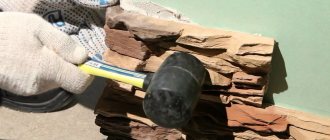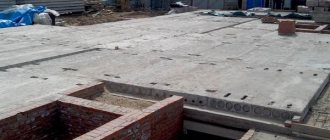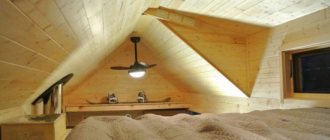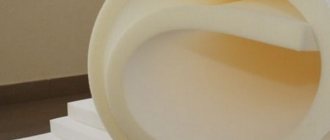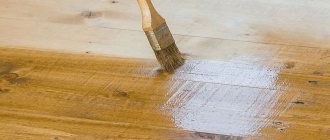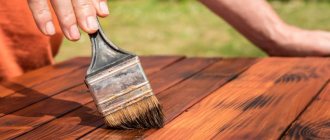Alkyd-urethane varnish is a mass of certain resins, particles of the urethane group, diluted with solvents. It is obtained from flax and tree oil. These compounds are used to renew or color wood, parquet flooring, parts of ships, boats, yachts, staircases, and other surfaces. They are also widely used for coating stone and metal.
There are 3 types of varnishes belonging to the alkyd-urethane group:
- Polyurethane (water based). It is odorless and resistant to high temperatures. Such substances are widely used in the form of aerosols.
- Two-component. It has a pungent odor, but is considered the most persistent. Before application, it is diluted with a hardener in the ratio: 10 parts of varnish to 1 part of hardener.
- One-component.
Alkyd and urethane compounds are not used when covering wood in wet rooms, for example, in saunas and baths.
Alkyd-urethane materials have the following advantages:
- dry quickly (5-11 hours);
- have strength;
- easy to lay on the base;
- resistant to water and chemical materials;
- protect the surface from debris and dust;
- have almost no odor;
- do not create slipping;
- emphasize natural wood patterns;
- protect the material from fungus, mold, microbes.
What it is?
Alkyd varnish is a mixture that contains various synthetic alkyd resins with organic solvents. The product has good adhesion and a high level of moisture resistance.
Alkyd varnishes are actively used for working with various types of surfaces.
- End parquet. Alkyds do not allow the ends to stick to each other, so surface stress is eliminated;
- Parquet floors with “warm floor” system;
- "Floating" floors;
- Parquet made from delicate types of wood that are highly sensitive to the environment.
When this varnish hardens, it forms a transparent and fairly hard layer. Many people say that alkyd products take a long time to harden. However, manufacturers have developed products with special additives, with the help of which they shortened the polymerization time. This means that the surface can be used after a short period of time.
After polymerization, a glossy or matte film is formed on the alkyd varnish, depending on the chosen product. The material that you will process with such a mixture will be provided with reliable protection against irritants of any type. Applying the alkyd mixture is quite simple, since the product has a thick consistency, due to which the product spreads well over the floor and other treated surfaces, creating a dense layer of film.
Manufacturers
Several brands are in wide demand among buyers:
- White house
- Parade
- Tikkurila
Alkyd-urethane mixtures from Parade were able to win a large audience, since this manufacturer sells varnishes with increased elasticity. Buyers leave reviews in which they report that the film that forms after applying the product does not crack or deteriorate for a long time. Alkyd products can emphasize the naturalness of wood material and make the floor more impressive. Parade offers its customers mixtures for exterior and interior use.
White house has won over customers with its affordable prices and low scent. The manufacturer produces high-quality varnishes that are characterized by high wear protection, rapid polymerization and a decorative component. Varnish is able to preserve the natural shade of wood. Just like Parade, the manufacturer produces products for working with outdoor and home surfaces.
Tikkurila is considered a trusted manufacturer of many materials for construction work. The brand has won the respect of customers and is known as a manufacturer of reliable and high-quality products. Tikkurila yacht varnish, which is characterized by fast polymerization and excellent spreadability, receives good reviews. The low price helps this brand become a leader among alkyd varnish manufacturers.
Description
The composition of alkyd varnish includes various synthetic resins, organic solvents and driers. These varnishes have a good adhesion rate and an excellent level of moisture resistance. Nowadays, the use of alkyd varnish is varied; it is used in the following areas:
- for processing end parquet. Since alkyd resins do not allow the ends of parquet dies to stick together, it is alkyd compounds that are used to treat wooden parquet, which prevents the occurrence of surface tension;
- to protect parquet floors where a heated floor system is installed;
- for covering floating floors;
- in order to extend the service life and protect parquet made from rare, delicate types of wood, which are very sensitive to various factors, including temperature and humidity.
Once the alkyd varnish is completely dry, it forms a very durable, hard and transparent protective coating. Some people are hesitant to use alkyd compounds because they think they take a long time to dry. But nowadays, manufacturers have developed special additives that greatly reduce the polymerization time of varnish. Many people are interested in how long does alkyd varnish with drying accelerators take to dry? Final polymerization will take approximately 1-2 days.
When the varnish polymerizes, it produces either a matte or glossy surface, depending on which product was chosen. Wood or metal that is treated with an alkyd solution becomes visually attractive and reliably protected from various negative factors, including chemicals, high humidity, various liquids, etc. Alkyd mixtures are applied very easily and quickly, they have a thick structure, spread well over the surface, while creating a fairly dense coating. One of the effective and popular varnishes is the product of the Kudo company; varnish solutions are produced in the form of aerosols and liquid mixtures.
Catalog
Ask a question https://poli-r.ru/article/alkidni-ili-akrilovi-lak
TD Poly-R LLC https://poli-r.ru Shcherbinka urban district, Simferopol highway, building 15/1 Moscow Moscow 142171 Russia +7 TD Poly-R LLC https://poli-r.ru Shcherbinka urban district, Simferopolskoye highway, house 15/1 Moscow Moscow 142171 Russia +7
The difference between alkyd-urethane and acrylic (water-based) varnishes, pros and cons.
Modern industry offers the buyer a choice of two types of coatings for one application, acrylic latex and alkyd resin. When making a choice, the buyer is based primarily on his own experience or on the advice of friends, and since alkyd products appeared on the shelves of our country much earlier, there is much more experience in the use and operation of such coatings, and aqueous solvent products produced in earlier times were not durable. Hence, most people have a stereotype that water-based products are not durable and can easily be washed off during wet cleaning. The purpose of this article is to tell you what the differences are between aqua varnishes and alkyd-urethane-based varnishes, what are the pros and cons of both products.
Compound
The basis of aqua varnishes is not water at all, but acrylic polymer. Plexiglas is a good example of the use of acrylic polymer. The basis of alkyd varnishes is alkyd-urethane resin, which is most often made from a combination of sunflower oil and polyhydric alcohols.
Basic properties
After complete polymerization, acrylic polymer is not afraid of significant temperature changes, exposure to ultraviolet radiation, or prolonged contact with water. Therefore, the acrylic polymer film retains its condition unchanged for a long time, and the color of the wood also remains virtually unchanged. This makes it possible to carry out local repairs of individual areas. And probably the most important plus is that acrylic varnishes use water as a solvent and have virtually no odor, which makes work more comfortable.
The final polymerization of acrylic latex takes from a week to a month (aqua varnish for parquet “POLI-R” gains hardness after 7 days). Until this happens, the surface must be protected from mechanical damage. The components used in the production of acrylic varnishes are more expensive, which affects the final price of the product. Aqua varnishes are a little more difficult to apply and require some skill. It is necessary to carefully smooth the varnish over the surface with a special brush with synthetic bristles, avoiding sagging, drips, and bubbles.
The alkyd resin film is smoother and harder. Alkyd resins polymerize much faster, and the surfaces are ready for use (alkyd parquet varnish “POLI-R” is ready for full use 3 days after applying the finishing layer). Alkyd varnishes are easy to work with; all brush marks are self-leveling, so even non-professionals can get good results.
The main disadvantage is the smell, which each person treats individually, some will find it strong, while others will not pay attention to it (alkyd parquet varnish “POLI-R” is Turkish-made, therefore it uses a solvent purified from essential oils, and accordingly has a weaker odor). Alkyd varnishes always have an amber tint, and accordingly, the color of any wood acquires a yellowish tint, which becomes more saturated under the influence of ultraviolet radiation. Because of this, the previous coating will always be different from the fresh one, so if an area is damaged, the entire coating will have to be redone.
conclusions
So, from the information described above, we can draw the following - acrylic varnishes have much greater advantages in terms of characteristics with regard to the application and operation of coatings, but the acrylic resin itself is weaker in characteristics than alkyd. Therefore, it is necessary to choose a floor varnish that contains a large amount of polyurethane - another type of polymer that has excellent wear-resistant and other useful characteristics, and is not harmful to health.
Therefore, parquet aqua varnish “POLI-R” containing a large amount of polyurethane is suitable not only for floors, but also for doors, children’s and adult furniture, walls, decoupage and much more. It is recommended to use “White House” acrylic varnish to cover surfaces that are not subject to severe physical wear, since they do not contain polyurethane, but these varnishes will easily withstand weather conditions.
Advantages and disadvantages
The advantages of alkyds include the following properties:
- solutions are resistant to temperature changes and humidity changes. There are no competitors for alkyd varnishes in this area;
- increased level of vibration resistance;
- the composition does not have adhesive qualities. Therefore, floors treated with this varnish will not creak;
- high decorative qualities. The product is able to penetrate deeply into the wood, thereby highlighting the natural beauty of the product;
- easy application due to thick consistency;
- after polymerization, the varnish forms a matte or glossy film;
- optimal resistance to mechanical loads;
- alkyd varnishes are resistant to contact with chemicals;
- mold or mildew does not form on the surface.
Among the disadvantages, users note the following qualities:
- The varnish takes a long time to dry. Polymerization takes more than a day. However, as described earlier, some manufacturers add special hardeners that shorten the hardening time;
- Until the surface dries, the varnish emits an unpleasant odor, which can be dangerous if inhaled. In order not to harm your body, you must leave the windows open until the product hardens;
- Alkyd products can wrinkle if you apply too much varnish to the surface. Therefore, the instructions for use should be followed;
- The service life of the surface is about 3 years.
Specifications
The constant and main component of varnishes is alkyd resin, which acts as a base. Among similar products, alkyd varnishes are unrivaled in terms of resistance to temperature fluctuations.
Vibration loads do not in any way affect the quality of the applied alkyd composition; in addition, the varnish does not have the adhesive qualities that many representatives of paint and varnish products have. The product is absorbed directly into the wood and does not penetrate into the floor cracks in the log house. Such product characteristics make it possible to minimize floorboard squeaks when treating the floor with an alkyd mixture.
The first alkyd-based varnish that began to be produced in Russia was the composition PF-231. The product is intended for use on all types of surfaces. One can note the visual attractiveness of the base obtained after treatment with this composition - the film evenly and neatly covers the working surface.
In addition to the positive characteristics, the composition also has some disadvantages. The main disadvantage is the short service life of the coating due to its minimal hardness. Due to this, after 2-3 years the surface of the wooden floor will have to be treated again. On other materials the composition will last many times longer.
PF 283 forms a glossy layer, notable for its decorative properties. Essentially, these products are a mixture of alkyd resin, fatty acids and natural solvents. In addition, the ingredients include a drier. Most often, such varnish is sold in a can as an aerosol of 150 ml.
PF-170 includes resin in combination with specific additives and aliphatic hydrocarbons. The composition can be used for wood, wood-containing materials, metal and ceramic substrates. In addition, bases treated with paints, enamels and primers are very often coated with a protective and decorative composition. The products are allowed for use indoors and outdoors. The varnish is manufactured in accordance with GOST, is resistant to chemical detergents and aggressive environmental factors, allows the surface to “breathe” and is very economical in terms of consumption.
Types of polyurethane paint
Funds are divided into 2 large categories:
- One-component compositions. No mixing of ingredients is required; the enamel is sold ready-made. You can begin application immediately after opening.
- Two-component polyurethane paint. You need to combine the ingredients supplied in separate packages.
According to the composition of the base
The single-component category includes:
- Organic paints. In addition to polyurethane, they contain toluene or xylene. The diluent becomes the appropriate solvent. The paint hardens when the components react with moisture present in the air. The setting time of the layer depends on air humidity.
- Alkyd-urethane enamels. The main ingredient is the varnish of the same name. The paint is characterized by a short drying time, not exceeding 90 minutes. The thinner for this composition is white spirit.
- Water-based products do not have a strong odor. When the paint thickens, you can dilute it with plain water. It is not necessary to use protective equipment during surface treatment. The hard film is formed by contact with moisture in the air.
One-component paint.
Powder paints
This enamel belongs to a separate category. It has the form of a homogeneous mixture, which includes dyes, essential resins, and fillers.
Powder enamel is characterized by high strength. In industrial conditions, it is used to protect structures operated in extreme conditions.
Category of powder paints.
Epoxy-polyurethane coatings
Such products form a durable film that is insensitive to abrasion and aggressive factors. They are used for painting structures operated in aggressive environments. Epoxy-polyurethane compositions are characterized by the best protective properties.
Epoxy-polyurethane coating with good protective properties.
Other two-component formulations
The enamel goes on sale in 2 buckets containing hardener and resin.
The advantages of such funds are:
- Possibility of preparing the required volume of solution. Unmixed paint residues retain their properties during storage.
- The course of the polymerization process without contact with moisture.
- Increased, in comparison with one-component compositions, the strength and wear resistance of the coating.
Two-component products are intended for painting structures that are especially susceptible to aggressive factors.
The components are mixed in a separate container. The paint must be used within 8 hours. The durability of the coating depends on the correct mixing of the ingredients and application technique.
Benefits and harms
The advantages of alkyd varnishes include the following characteristics:
- resistance to temperature and humidity fluctuations;
- vibration resistance;
- lack of adhesive properties;
- high decorative qualities of the resulting coating;
- when using a brush, the composition is applied very quickly, since it has a thick consistency;
- after drying, a glossy or matte film forms on the base;
- resistance to mechanical loads;
- the composition does not lose its properties upon contact with chemical compounds;
- prevents the formation of mold or mildew on the material.
According to consumer reviews, the following disadvantages of alkyd compositions stand out:
- Complete polymerization of the mixture requires quite a lot of time, usually about a day. To eliminate this disadvantage, most manufacturers began to include hardeners in the composition, which help reduce the time required for the mixture to dry.
- A base that is not completely dry and treated with alkyd varnish has a sharp, specific odor that is dangerous to human health. To eliminate the risk of vapor poisoning, the room should be well ventilated while the film is curing.
- Excessive amounts of alkyd mixture will certainly wrinkle the base, so when working with the product you must follow the instructions.
Popular brands
Alkyd varnish PF-231 belongs to one of the first series of parquet varnishes produced in Russia. The composition is easy to apply, and the film looks neat and provides decent protective characteristics. However, the main disadvantage of PF-231 is very significant: the coating does not have a long service life and must be replaced after 2-3 years.
MCh-0163 is a two-component product that includes alkyds, urea-formaldehyde resin, and an acid hardener. In comparison with PF-231, this mixture is more competitive: it resists moisture more reliably and takes mechanical loads better. The disadvantages of MCh-0163 should be considered instability to ultraviolet radiation, insufficient elasticity of the film coating, a rather pungent odor, and the possibility of bubbling on the surface during varnishing.
EP-2146 is a one-component composition with good performance properties. Epoxy resin is used as a modifier here. EP-2146 has decent hardness, moisture and abrasive resistance. EP-2146 is used for varnishing parquet, veneer, fiberboard, chipboard, plywood.
Kinds
Alkyd varnishes are divided into the following groups according to type and form of release.
One-component
Conventional varnishes containing only an alkyd-resin base. Before use, the product is diluted with a solvent in the proportion recommended by the manufacturer. If the ratio of base and thinner is not maintained, the composition will turn out to be too fluid, which will complicate its application and reduce the strength characteristics of the varnish film.
Such coatings do not have high strength characteristics, so they are most often used for varnishing furniture, wall cladding, and decorative elements. The advantages include a long shelf life in printed containers and a low price. The disadvantages include the need for a long break between applying several layers (24–48 hours).
Two-component
They are produced in two packages: the first contains the alkyd varnish itself, and the second contains the hardener. Before application, the compositions are mixed in the ratio specified by the manufacturer, which is not recommended to be violated. If you add too much hardener, the composition may begin to thicken before the end of application. If you add too little drying agent, increasing the drying time can lead to insufficient strength of the varnish coating and dust adhesion.
The advantages of drier varnish based on alkyd resins are fast drying (the composition must be applied within 8 hours), as well as higher performance characteristics. Two-component varnishes are significantly superior in strength, water resistance and wear resistance to their one-component counterparts. Disadvantages include an unpleasant odor during application and drying, as well as a possible decrease in the transparency of the varnish film when exposed to sunlight.
The main purpose of drying varnishes is the coating of wooden floors, as well as the treatment of external wooden structures.
Alkyd-urethane
This type of paintwork material is made from an alkyd resin modified with toluene diisocyanate, as a result of which its molecular weight increases. This leads to a change in the drying process of the varnish coating: first, the volatile substances of the solvents evaporate, and further hardening of the layer occurs as a result of an oxidation reaction.
The advantages of alkyd-urethane compositions are their improved properties compared to conventional alkyd varnishes, such as abrasion resistance, resistance to prolonged exposure to water and ultraviolet radiation, and mechanical strength of the film. In addition, such varnishes dry faster, but between applying layers it is necessary to take a break of at least 24 hours to avoid the effect of the previous layer dissolving. Among the disadvantages of alkyd-urethane varnish, a high content (up to 50%) of solvents is noted, which makes the process of applying the composition fire hazardous and toxic. Therefore, compliance with safety measures is very important when working with such paintwork materials.
Yacht varnish
A separate category includes the so-called yacht varnishes - improved compositions for effectively protecting wood from atmospheric influences and water, including sea water. In addition to their direct purpose (coating decks and other elements of boats and yachts), such paints and varnishes are used for processing wooden facades, gazebos, garden furniture and other surfaces exposed to weathering.
A significant disadvantage of yacht varnishes is the use of toxic substances for their production - toluene and xylene, thanks to which the coating obtains its basic properties. Therefore, such compositions are recommended for external use, although some manufacturers produce special types for interior use.
In terms of their composition, yacht varnishes are alkyd, urethane-alkyd and alkyd-urethane. In the last two compositions, the percentage of alkyd resins and urethane modifiers changes.
Alkyd varnish for metal
For the protective coating of metals against corrosion, compositions based on alkyd resins modified with various polymers have been developed. Such varnishes form a durable, mechanically resistant film with high adhesion to various metals (ferrous, galvanized, non-ferrous). Available for both domestic use and industrial use. In addition to water resistance, such coatings are antistatic, can act as an electrical insulating layer, and are resistant to thermal and chemical influences.
How to choose alkyd varnish
You need to choose a varnish carefully and be sure to familiarize yourself with its different types before purchasing.
The product must meet certain criteria, only in this case the work will be successful and the coating will be used for the longest possible period of time.
- It is necessary to take into account the strength of mechanical loads on the surface. If they are not serious (implies operation by two to three people), it is recommended to use water-based varnish compositions.
- If you plan to varnish the flooring in the kitchen or hallway, it is better to give preference to mixtures with pigments. They protect the surface well from contamination and dust and other small particles will not cling to them. A good alternative for covering kitchen floors would be to use a non-aqueous polyurethane mixture. It is easy to apply, interacts well with surfaces and is easy to care for.
- To cover floors exposed to serious mechanical loads (for example, offices, restaurants, etc.), it is better to choose varnishes that have a high level of moisture resistance.
Yacht varnish products
Yacht varnishes are used for application to wooden surfaces (yachts themselves). But this does not mean that it cannot be used to cover other surfaces that are operated at high levels of humidity or are constantly in contact with water.
However, such materials are not suitable for painting substrates indoors. This is due to the fact that they are toxic and unsafe.
Some of the main additives are xylene and toluene.
Of course, such compositions are very durable, strong and resistant to moisture, but it is extremely undesirable to apply them to parquet floors or furniture that is used in residential buildings or other similar premises.
Criterias of choice
When choosing an alkyd varnish, the following aspects must be considered:
- The choice of varnish type depends on the surface that you plan to cover with it. For wall cladding and decorative elements, a one-component alkyd product is suitable; for indoor flooring, it is better to use alkyd-urethane, and for outdoor use or deck covering, it is optimal to use yacht varnish.
- For floor coverings, you should choose wear-resistant types with maximum water-repellent effect.
- Some manufacturers add coloring pigments to varnishes that are transparent in nature. Such compositions are designed to provide maximum protection for wooden floors from dirt and water, and expand the decorative functions of the varnish coating.
Advice! For interior work, choose varnishes with a minimum amount of solvent, which are less toxic.
Briefly about the main thing
Yacht varnish, an invention of shipbuilders, has taken a strong place among finishing materials for the residential sector. The chemical composition determines its unique properties: moisture resistance, wear resistance, strength and an impressive finishing result. The volatile substances of the benzene group included in the varnish negatively affect health.
Ship varnishes are usually divided into groups according to the main substance included in the formula. There are four groups on sale with different characteristics and degrees of toxicity. When choosing the optimal product, it is necessary to take into account the scope of its application and the degree of light reflection.
Ratings 0
Consumption
Many people are interested in how much alkyd varnish costs. This indicator depends on the type of mixture and your talent. Experts advise applying 2-3 layers of varnish. Each level should be applied only after the previous one has dried. Thus, it will take you at least 3 days to treat the surface.
The consumption of alkyd products is 50-75 grams per square meter. If you use more varnish than required, the polymerization time will increase. You also risk getting a less durable surface.
Before use, some brands should be diluted to a working consistency with xylene or solvent. You can mix one of these drugs with white spirit in a 1:1 ratio.
How to dilute it?
White spirit is used as a solvent for alkyd compositions, which begins to evaporate as soon as the composition is applied to the surface.
Then polymerization of the composition occurs. It is caused by chemical reactions between the molecules of resins and other components. To remove the varnish coating from the surface, a remover is used. It is a special chemical that destroys the varnish and lifts the film from the material. The varnish can be washed off with powder products, pastes of different consistencies, as well as by scraping or heat treatment.
Scope of application
In addition to wooden surfaces, other materials can also be treated with a polyurethane mixture.
Let's consider the main area of application of this coating:
- as additional protection for walls, floors and ceilings made of various materials;
- protection of wooden furniture and stairs from chemical and mechanical influences;
- formation of a transparent film on ceramic tiles, as well as impregnation of surfaces made of concrete, brick walls and slate roofing;
- to obtain the effect of a wet stone;
- to protect mineral substrates from corrosion;
- protection and improvement of the aesthetic qualities of parquet flooring;
- to protect stone, metal and concrete bases from rust formation.
How long does it take to dry?
Immediately after application, alkyd varnish looks like glue. After about 10 hours, some varnishes that have special hardeners in their composition will already harden. Typically it takes 24 hours for one coat to dry.
It is worth noting that the thickness of the varnish film after drying may become smaller, in this case it all depends on how much of the solvent has evaporated. Its content in alkyd mixtures may vary, and based on this indicator, the toxicity level of the composition increases or decreases.
Application technique
To achieve maximum protective effect, any type of alkyd varnish is applied in 2–3 layers. It is not recommended to apply the varnish in a thick layer: the average consumption should be 50–75 g/m². When carrying out painting work, the air temperature must not be lower than +5 °C.
Important! Applying a new layer of varnish is possible only after the previous one has completely dried (24–48 hours depending on the type). If you neglect this rule and apply a second layer to a still sticky surface, the coating may wrinkle and will need to be completely removed with a sander. Wrinkles can also form if you apply too thick a layer of varnish in one pass.
Before applying varnish, the surface to be treated must be cleaned of dirt and dust, and any old peeling paint or varnish coating must also be removed. Wooden surfaces are sanded with fine sandpaper until matte. Wood exposed to weather conditions must be dried before sanding. Metal surfaces are cleaned of rust, scale, and degreased.
Advice! Wooden surfaces made from fresh wood, as well as those exposed to precipitation, are recommended to be treated with colorless antiseptic impregnations before applying the main varnish coating.
The one-component varnish is thoroughly stirred before use, and if necessary, to increase its fluidity, a solvent is added to it. The two-component composition is mixed in a separate container in the proportion recommended by the manufacturer.
The varnish is applied with a spray gun or brush along the fibers. In this case, it is best to use a paint sprayer for glossy varnish, and apply matte varnish with a brush or roller. To obtain the smoothest possible surface, before applying the second or third layer of varnish, it is recommended to lightly sand the previous layer with fine sandpaper.
Methods of varnishing wooden surfaces
Flawless application of varnish on wood is done using special tools. They are selected based on the volume of work to be done and personal preferences.
Roller
Designed for covering smooth surfaces with the material. Using a roller you can quickly cover large areas. Moreover, the varnish will be applied in an even layer. Additionally, you will need to purchase a plastic tray.
The use of a roller is advisable for large areas with a flat surfaceSource baltija.eu
Brush
It is used most often and allows you to treat even hard-to-reach areas. Using a brush, it is easy to apply the material to uneven areas.
Particular attention must be paid to the choice of bristles: it should be of medium length. When treating wood with alkyd varnishes, it is necessary to use fibers of natural origin; for finishing with acrylic compounds, brushes with artificial bristles are more suitable
The quality of the chosen tool will largely determine the outcome of the work.
Experts often recommend choosing a flat brush with a width of about 6 cm
In the process of applying varnish, it is important to ensure that it does not drip from the bristles and that the coating is uniform.. A convenient brush allows you to apply the material even in the most difficult to reach places. Source strourem.ru
A convenient brush allows you to apply the material even in the most difficult to reach places. Source strourem.ru
Spray gun
A professional tool is used when processing large surface areas, allowing you to apply varnish in an even layer, preventing the formation of drips
When using such a mechanism, you must take precautions, be sure to wear protective overalls, a mask and goggles
The use of spray guns guarantees the creation of an even varnish layer and does not allow accidental drips. Source instrumentoria.ru
